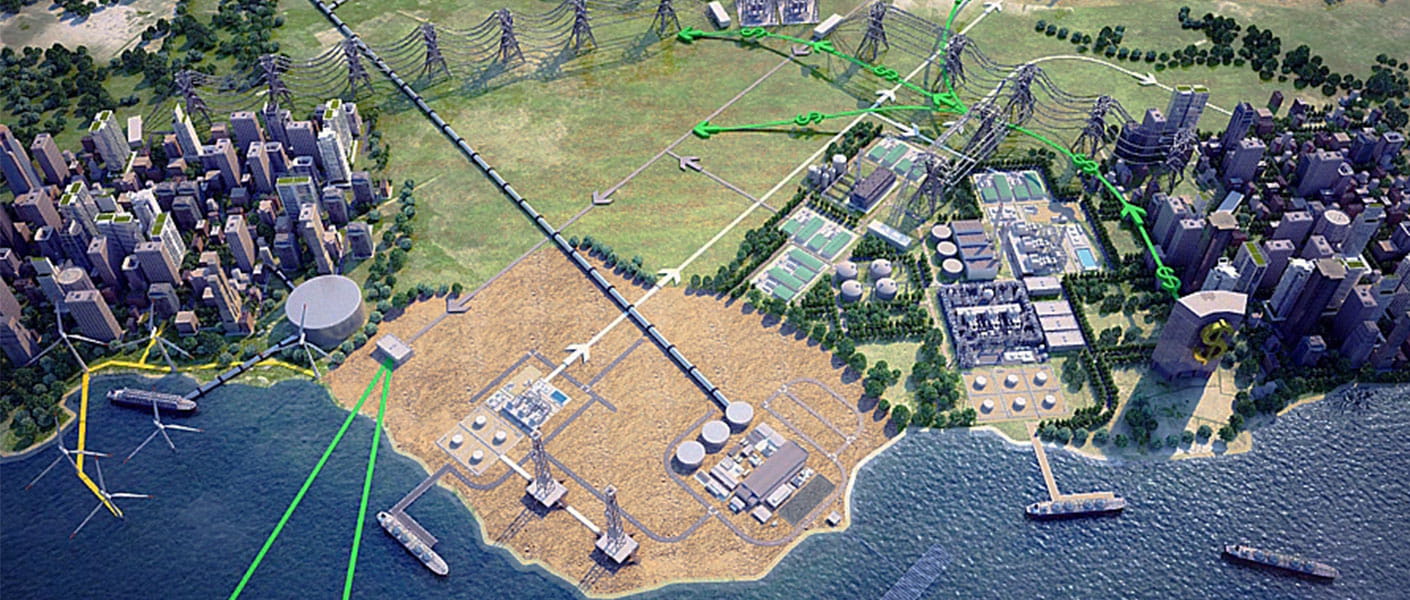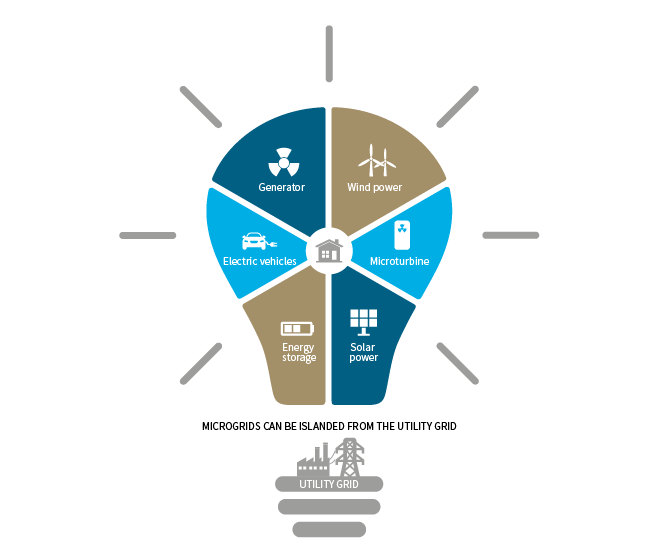Community leaders and facility managers are asking electric utilities questions about their local services. Is the electrical grid resilient enough to reliably support critical infrastructure during a natural disaster or a localised grid failure? Can the grid meet future customer needs and integrate new technologies while also helping reduce costs? Can the electrical grid be designed to better support sustainability goals, carbon mitigation, and local climate change adaptation? These critical, interrelated questions require dialog about the optimal use of Distributed Energy Resources (DERs), and in particular, the use of these resources within the Community Microgrid architecture.
What is a Community Microgrid?
A Community Microgrid is a subsystem within the electrical grid, having interconnected loads, operating within defined electrical and geographic boundaries, and capable of automatically disconnecting from the macro grid and operating in 'island' mode. When disconnected, or in 'islanded' mode, a microgrid can automatically shed noncritical electrical loads while critical systems are supplied power through the use of locally connected Distributed Energy Resources (DER). In a shift away from fuel-burning technologies, these DERs increasingly feature Solar PV installations (roof-top systems, solar car port systems, etc.) and Battery Energy Storage Systems (BESS). DERs used in microgrids may also include Combined Heat and Power (CHP) facilities, natural gas turbines or microturbines, fuel cells, and diesel generators. These generation and storage technologies are typically supported by Demand Response (DR) services and Energy Efficiency programs.
A key characteristic of microgrids is their ability to face the grid as a single controllable entity. Microgrids serve multiple purposes, ranging from reliability, to supporting the integration of renewables, offering ancillary services, and economic optimisation of infrastructure investments. The defining feature of Community Microgrids is that they extend to multiple stakeholders or owners and are designed to provide specific public benefits for the local community.
Microgrids: a historical solution
Thomas Edison is given credit for having built the first microgrid in 1882, which was the Manhattan Pearl Street Power Station. The Edison Co. later installed an additional 58 systems serving areas ranging in size from a few buildings to a few city blocks.1
Microgrids have also been used over the past century on islands, in rural communities, and to support military FOBs (Forward Operating Bases), often relying on large diesel generators to provide power. Because these systems are not tied to the larger grid, they are considered 'off grid' or 'fully islanded' microgrids under the current terminology (as opposed to 'dynamically islanding' microgrids, or simply 'microgrids'). As concerns of fuel cost volatility and carbon impacts increase, and with solar PV costs continuing their decline, more focus is shifting to DERs as a means of lowering costs by improving efficiency and integrating renewables, as well as improving resiliency for both off-grid and on-grid systems.
According to GTM Research, there are now over 160 microgrids operating in the US today with 1,649 MW of associated generating capacity. This is projected to increase to 4.3 GW by 2020, as it has become apparent that these systems offer 'stacked” benefits across multiple stakeholders. This includes benefits that can be realized by utilities, consumers, municipalities, and third-party providers. One example of this is the improved efficiency that results from energy storage being located close to the point of end use. The number of services increases as you move the storage asset closer to the point of end use, as presented by a Rocky Mountain Institute study which identified up to 13 services that battery energy storage can provide to stakeholders.2
Due to the array of benefits offered by these systems accruing to a variety of stakeholders and new business models, there has been a shift away from single ownership microgrids toward community microgrids and other multi-owner configurations. Electric utilities also stand to benefit from microgrid projects, as they can help to defer, even eliminate, larger capital projects that may be needed in other areas of the grid.
Resiliency and public safety
Recent studies have shown that in the last decade there has been a statistically significant correlation between the average number of power interruptions per year and measurable temperature spikes associated with the overall trend of climate change. Impacts include increasing severity of storms in recent years, including wind speed, precipitation (flooding), and lightning strikes. In turn, these events require an increased need for first responders to mobilise (fire, police, ambulances, and EMTs) to assist during service disruptions and displacements of people and businesses. The combination of greater density of customers in urban areas, greater reliance on the wide variety of services requiring electricity, and longer durations of power interruptions is exacerbating the costs to the affected societies, making grid resilience a priority for communities.3
The event that brought these issues into the national spotlight was Hurricane Sandy, which arrived on the shores of New York and New Jersey in October 2012. Communities quickly found that maintaining power to critical infrastructure in the face of such events was not sustainable. This storm alone caused more than 8.1 million homes and businesses to lose power, resulting in more than $25 billion in lost business, which caused many companies to close their doors permanently.4
Community microgrids will improve system resiliency and can maintain the operations of critical infrastructure during natural disasters, accidents, and other events causing grid failure. These systems can keep the power on at hospitals and medical facilities, police and fire stations, emergency communications centers, schools and day care centers, water supply and treatment plants, airports, hazardous waste facilities, grocery stores, and gas stations. Not only does this help to protect those living and working in these areas, it is also an effective means for communities to attract new businesses by ensuring an uninterrupted power supply and availability of essential public services.
Economic Development
For those living in communities where microgrids are operating, residents and employees are reassured that during a power outage event, critical infrastructure will not be disrupted. Communities know that when problem situations arise, they will continue to have access to electricity and the services it supports within the boundaries of the community microgrid. Some communities have even designed areas within the microgrid where people can take refuge during a disaster, gathering to exchange information, charge phones, and get in touch with distant family members.
Communities that install microgrids strengthen their economics in several ways, from attracting new businesses to reducing electricity rates. Energy costs are often added to the prices of goods and services we buy. Microgrids offer a means to keep electricity rates in check through better grid management. These savings can, in turn, be passed along to residents and local business owners, keeping their costs lower.
Typically, the first step when developing a microgrid is to evaluate ways to promote energy efficiency improvements in the buildings served. This can reduce both the peak load and the required usage over time within the microgrid, cutting costs associated with solar PV panels, energy storage systems, and/or generators and required fuel.
In addition to the services provided locally, microgrids can support the macro grid during periods of peak demand. Advanced control software can monitor load profiles, allowing solar PV, storage systems, and conventional sources of generation within the microgrid to shave peak loads, reducing utilities’ 'Peak Demand' charges. This can significantly lower utility bills, and can also help the local utility save money by deferring costly upgrades to transmission lines, substations, and distribution feeders. This is referred to as Transmission and Distribution (T&D) deferral or a “non-wire alternative.”
Power generated within these microgrids can also be aggregated to support ancillary services such as Frequency Regulation, which can be sold to the market creating new revenue opportunities when the system would otherwise sit idle. And while heat generated in a typical central power plant is otherwise lost, requiring coolant and exhausting, the use of CHP systems within a Microgrid provides steam to heat or cool local buildings, improving their economics and fuel efficiency up to 99% or better.
Communities with microgrids can advertise lower and more stable electricity costs, a resilient electrical system, improved first responder support, and can guarantee power to dedicated emergency food, shelter, and pumping stations during a crisis, which together attract more businesses, jobs, and safety-conscious citizens. With their higher level of reliability, communities that offer microgrids will find themselves better positioned to compete for more highly sought after businesses, while those that do not will begin to find themselves left behind, playing catch-up. This includes being able to attract desired industries sensitive to power outages like software services based businesses, data centres, research and lab facilities, pharmaceutical manufacturers, and other high-tech industries.5
The modern microgrid: a scalable solution
The use of Community Microgrids is accelerating the transition to sustainable renewable energy usage while promoting a more modern grid. Modernising the grid to make it 'smarter' and more resilient through the use of cutting-edge technologies, equipment, and controls enables electricity to be delivered more reliably and efficiently. Work completed today will create the standard practices and methodologies that any community can use to optimise and simplify the deployment of renewable energy where it is needed most in the electrical network, to the benefit of communities looking for resiliency and safety, sustainability, modernisation for future growth, and promotion of community development, and, in turn, supporting America’s economy, national security, and public health and safety.
For more information, contact Tristan Jackson, Director, Smart & Distributed Energy
References
-
Renewable Energy Resilience (http://peterasmus.com/journal/2009/11/6/the-microgrid-revolution.html)
-
The Economics of Battery Energy Storage (https://microgridknowledge.com/us-microgrid-market-gtm/)
-
Recent trends in power system reliability and implications for evaluating future investments in resiliency (https://emp.lbl.gov/publications/recent-trends-power-system).
-
Hurricane Sandy By the Numbers: A Superstorm’s Statistics, One Month Later (http://nation.time.com/2012/11/26/hurricane-sandy-one-month-later)
-
Four good reasons for community microgrids (http://www.obg.com/insights/four-good-reasons-for-community-microgrids)


